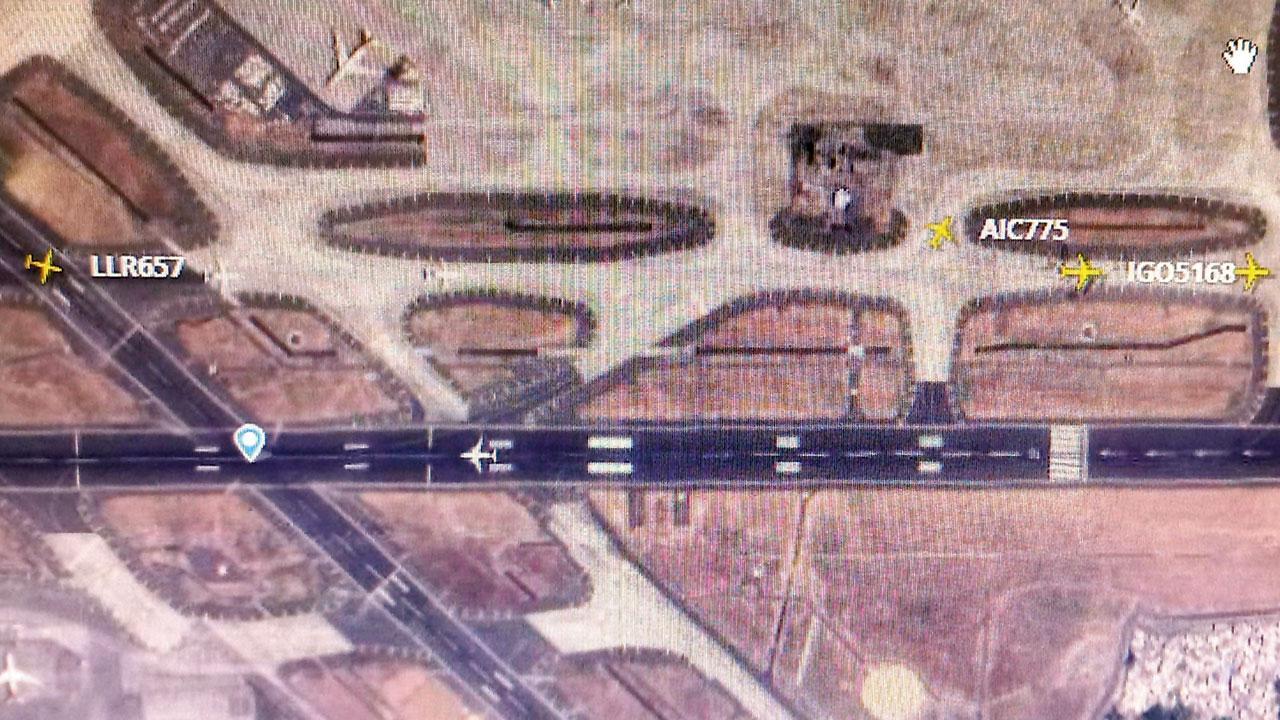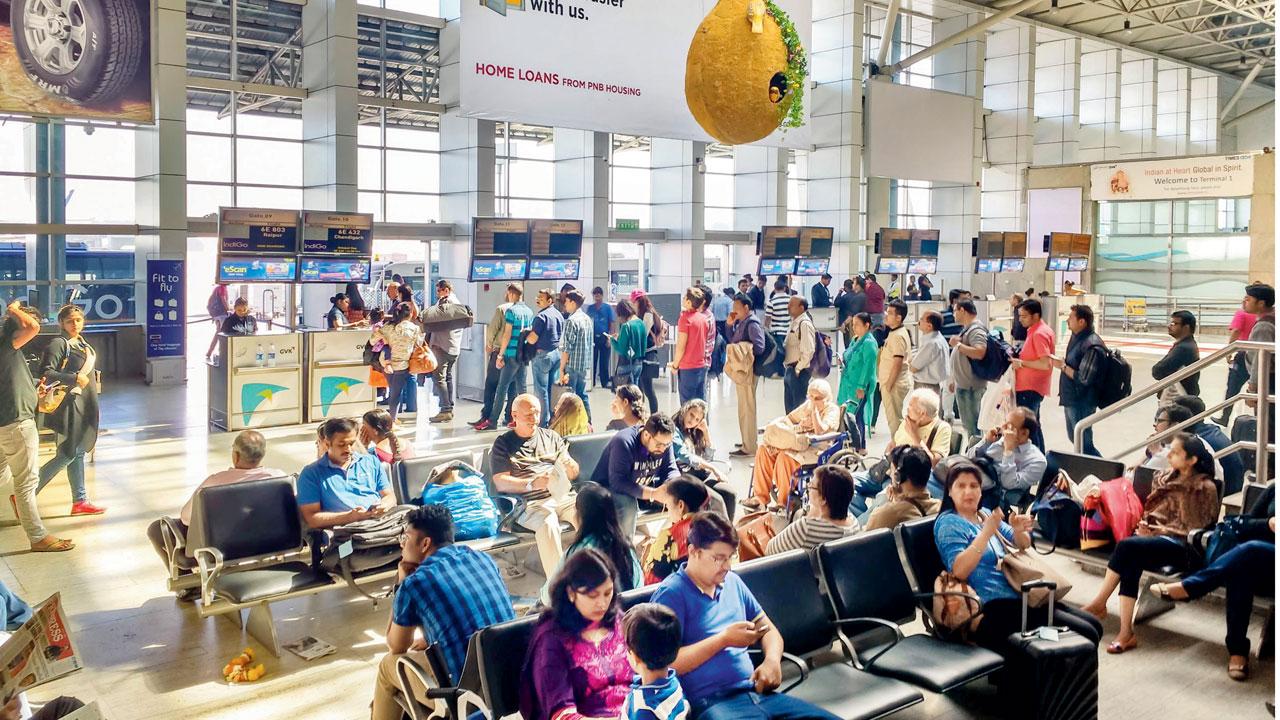Sole taxiway, mid-air emergencies, inflated buffer times—so many things are at play

Three aircrafts holding short of Runway 09/27 on March 13, 2024 awaiting clearance for takeoff
Key Highlights
- CSMIA has been facing delays in planes taxing in and taking off
- Mumbai Bengaluru flight was delayed by 34 minutes on the taxiway
- As a result, two other flights that were scheduled after it also saw delays
Found yourself waiting for take-off? The Chhatrapati Shivaji Maharaj International Airport (CSMIA) has been facing delays in planes taxing in and taking off due to problems beyond the scope of ordinary air traffic control (ATC) traffic jams and delays. For instance, on February 29, a Mumbai Bengaluru flight was delayed by 34 minutes on the taxiway. As a result, two other flights that were scheduled after it also saw delays ranging from 20 minutes to two hours.
What’s the cause? And more importantly, what can the solution be? mid-day investigates:
ADVERTISEMENT
Lack of parallel taxiways
The airport’s current layout lacks parallel taxiways, crucial to enhance efficiency of aircraft movement on ground. "Deployment of planes for take-off is slowed down when flights congregate on a single taxiway from many terminals. This causes ground traffic and potential delays,” an airlines staffer told mid-day. A CSMIA source said construction of a parallel taxiway is underway. “A rescue and firefighting facility is being moved out of the proposed parallel taxiway's path,” the source said. “It is being moved to a location close enough to reach a site within two minutes of an emergency call. The building, which is in close proximity of the runway, will be demolished and a new parallel taxiway will be constructed. This will take 18 months, post demolition.”
Delayed Automation
"Automation is vital to streamline departure procedures and reduce our (ATC) workload so that personnel can concentrate on actual departures and arrivals,” said a retired ATC personnel, requesting anonymity, “The delay in implementing this automation has exacerbated the already congested airspace. Even automating the departure phase will free up cognitive intelligence of the controllers that can be utilized in the arrival process.”
Also Read: 247 Indians grounded by airlines for bad behaviour

Rising instances of delays in flights taking off and the resulting cascading effect has prompted staffers and experts to ponder solutions. File pic
Currently, aircraft start times are determined manually by controllers using Targeted Off Block Time (TOBT), generated under Airport Collaborative Decision Making (ACDM). There are disparities between declared TOBT and the actual level of flight readiness since many airlines neglect to update their TOBT. The controllers’ ability to control departure sequences at the last minute is hampered by this,” he added. An official with the Airports Authority of India said automation is expected to be complete in a few months.
Other factors
“Apart from infrastructure and automation issues,” Captain Mohan Ranganathan, an aviation expert, says, “inflated block times set by airlines, and inadequate slot allocations also play a role in delays. Inflated block time is the buffer time added to a flight's schedule by the airlines to account for potential delays; when consistently overestimated, it can contribute to unnecessary delays.”
According to data from DGCA (Directorate General of Civil Aviation), 65 per cent of incoming aircraft at CSMIA experience delays. Airlines may claim their flights arrived earlier than expected by displaying longer block times, but affects distribution of slots, which adds to delays.
“In a day, an aircraft covers multiple cities across the country,” Captain Ranganathan explains, “If the flight is delayed at any particular leg, there’s a domino effect on consecutive legs. Punctuality at all destinations depends on the on-time performance of other aircrafts too. While Mumbai airport has two passenger terminals (international and domestic), traffic movement is stretched because only one of the two intersecting runways can be operational at any given point. The flights get delayed at both ends—departure and arrivals. In comparison, Delhi’s Indira Gandhi International Airport, has four operational runways and three passenger terminals."
Inadequate slot allocation
For flights parked overnight, on-time morning departures are performed around 85% of the time. “On-time morning departures for flights parked overnight are at 85 per cent,” said the former ATC personnel. “But as the day wears on, delays mount. Mumbai airport is a centre for transfers, and a controller's planning is affected by crew arrival delays and other technical issues. The more the air traffic, the more severe the delays. In addition to commercial passenger flights, CSMIA also handles cargo flights, business jets and VIP movements. Congestion can be caused by excessive slot distribution by the airport operator with limited time margins, non-adherence to slots by airlines, and non-scheduled operations at peak hours."
When distributing slots, factors such as go-arounds and foreign objects on the runway are not sufficiently taken into account, which results in congestion and reduction in hourly capacity. “A pilot decides to go around instead of landing, due to many reasons such as not enough visibility, or potential collision with other vehicles on ground, which can save lives lives,” explains the personnel, “But this disturbs the allocated slot patterns, and increases the ATC’s load as they have to monitor the flight in the holding pattern and make a slot available for it to land. They prioritize air-bound flights over ground ones as the former have limited fuel, and are burning it constantly; they need to be brought on ground on priority.”
In light of these complications, the recent MOCA (Ministry Of Civil Aviation) decision to reduce flights by roughly 40 a day was a positive move. Yet, CSMIA continues to experience delays. Prior to flight restrictions, the airport serviced 970 to 980 flights per day, going up to 1,000 flights and 1.6 lakh passengers on heavy days. It now serves about 950 flights every day. “Seventy-two flights that were supposed to depart on February 25 actually took off on February 26,” the ex-ATC says, “If a flight declares PAN (urgent but not emergency call by pilots to ATC), everyone else on the [radio] frequency is instructed to not intervene between the pilot and ATC communication. This causes delay in other flights receiving landing or take-off clearances.” Similarly, if a pilot declares ‘MAYDAY’ (immediate danger to life or property), other radio traffic on the frequency is shut down, and the airport may be shut for departures and arrivals till the emergency is solved.
The other flights go into a holding pattern, and flights that have not entered Mumbai airspace are diverted to other airports. This causes a delay at the airport where the emergency is declared, and also at airports where the flights are diverted. "It is necessary to modify slot allocations to take unanticipated circumstances like go-arounds or brief runway closures into consideration,” says another aviation personnel. “Complying with cooperative decision-making and CSMIA-mandated infrastructure renovations are essential. Upgrades to integrated tower work position and more effective utilisation of airspace have to be made too.”
Adv Yashwant Shenoy, an aviation rights activist, brings in the human aspect. “The delays have a significant impact on passengers and airlines with longer wait times, potential missed connections, and overall travel disruptions. The airlines will not step up to help them if they miss a connecting flight. Similarly, since MoCA cancelled flights, demand for seats has increased substantially causing the fare to rise over 50 per cent.”
Delays affect everyone--airlines incur extra costs due extended turnaround times and reduced operational efficiency. Sometimes, they have to enlist fresh cabin and cockpit crew to comply with restrictions on the number of hours an individual can be on flight duty. This rule, also known as Flight Duty Time Limitation (FDTL), safeguards the crew against fatigue that can lead to judgement errors which cause full-fledged disasters.
 Subscribe today by clicking the link and stay updated with the latest news!" Click here!
Subscribe today by clicking the link and stay updated with the latest news!" Click here!








